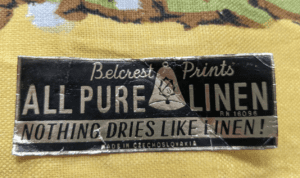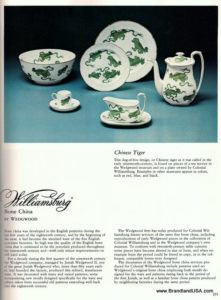
This week, John Kelly of The Washington Post reminisced about the clear Nescafe globe mug, famous from 1970s commercials. Kelly was kind enough to mention a column on General Foods International Coffee, which is still sold as Maxwell House International Coffee.
One of Kelly’s readers, in a comment, mentioned the company that made the mugs, Belcrest Inc. In the comments, Keith Jackson wrote that the cups were made by in Moonachie, N.J.
“My father was the factory manager,” said Jackson. “I think I broke my last one 5 or so years ago.”

Belcrest was one of dozens of china companies producing in the mid 20th century, and one of the many New Jersey pottery and china companies. While there are plently of Belcrest products on Ebay and Etsy, there is little other information online.
The company sold a large number of china patterns over their history, some made in the United States, and others made in Germany. They also sold glassware, so it would be a logical source for producing specialty glass mugs for an advertising campaign.
Online today, there are Belcrest collectable plates, including one specially made for the Meadowlands featuring legendary jockey Bill Shoemaker.
Patterns Available for Collectors

Their list of Belcrest china patterns is voluminous. In some cases, it very much looks like what some would disparagingly call “grocery store china.”
The used china house Replacements Ltd. has dozens of Belcrest patterns, in names that include Sea Island, Corsage, Brocade, Jacqueline, Empress, Donna Marie and Barvaria. The patterns are a bit precious, however, and do not have the bold patterns or colors seen in English bone china.
Instead, they are a bit dainty, which would have been stylish in the 1950s, 60s and 70s. There is also a preference for silver, rather than golds, as trim. Belcrest did offer a Lenox gold looking pattern, perhaps modeled after Lenox patterns like Tuxedo.

Etsy not only has many versions of the china offered by sellers. There are also imported linens under the Belcrest brand. This would be a natural extension of the brand. The linens were imported, from not only Japan, but Czechoslovakia and the “People’s Republic of China.”
Looking at the selection of Belcrest china patterns for sale online today, it seems like the company missed the trend of bold patterns and colors of the 1960s, except for the linens. At that time, and into the 1970s, brands like Marimekko and Vera introduced bold colors into housewares, and funkier bright patterns.
New Jersey China, Pottery and Glassware

Some of the Belcrest china was imported from Germany, but most was made in the United States, and most likely New Jersey. New Jersey was a center for the manufacturing of just about everything during the 20th century, from pharmaceuticals to ships.
China and pottery were a key part of Jersey manufacturing well before the Civil War, even. The most famous maker of New Jersey China was Lenox, founded in 1889. The Metropolitan Museum has work from Lenox in their collection. The company decamped to North Carolina, and later shut down U.S. production.
But there were other New Jersey ceramics companies with a strong creative and artistic character. For instance, there are also items from the Ceramic Art Company in Trenton, N.J. in the Met. Another Jersey maker was the Trenton Tile Works.
Through the early 20th century, the region not only had the manufacturing expertise, but it had manufacturing showrooms in the city, connections to transportation, and hundreds of independent department and housewares stores that would stock the items. This meant that there was an enormous amount of variety in the products.
Natural Advantages for Jersey Manufacturing
New Jersey also had another asset. Clay.
In the 19th Century, the Smithsonian sponsored a survey of the multiple aspects of the clays of New Jersey. The book The Clays and Clay Industry of New Jersey is a geograph and economic survey by Heinrich Ries, Henry Barnard Kummell and George Knapp. The book details the chemical and rock makeup of the soil of New Jersey, especially as it relates to terra cotta, brick and pottery uses. The Biodiversity Heritage Archive digitized the book, which was originally published by in Trenton, N.J. by printers MacCrellish & Quigley.
Reading the over 400 page book today, it is a not only useful history and science, but perhaps a blueprint for what could be, again, in New Jersey.
Below, some images of Belcrest products.

















Mr Jackson was incorrect in saying his father was the “factory manager” there was no such title. His father was the manager of the shipping department. I know this as a fact because my father was the owner and President of Belcrest Inc. Bernard Blum. If anyone was the “factory manager” that would have been the Vice President, my big brother Steven Blum.
If you look at the insignia of the the company you’ll actually see an L & a B They we’re a combination of my mother’s name LaVina and my father Bernard.
There was no such design named “Bavaria” Bavaria is the southern part of Germany where the China came from. It’s where Munich is located.
Belcrest never had anything to do with linen nor did it ever make its own china or pottery. It was one of the most diversified custom decorators of fine china and glassware.
Most of the glassware was purchased from glass manufacturers such as Libby Glass and Anchor Hocking in Ohio. It was Libby Glass who manufactured the world mug, but they told Necafe it was an impossible surface to print on and suggested if anyone could actually do it, it would be Belcrest Inc. and they were correct.
In 1976 Belcrest was the sole licensee in the US to print on glass and ceramics for the Bicentennial. A collector plate with the American Seal and 22k gold trim was sent to the Whitehouse.
Daniel Blum, you might be able to help me with some information regarding Belcrest China. I have a set with the exact same shape serving pieces as Pickard China. I am trying to find out the connection and how that could be? I am also checking with Pickard but so far with no success. Did Belcrest buy blanks from Pickard?
I would like some more information, if possible, concerning what all companies Belcrest bought china blanks from.
Wonderful interesting website of historical American products packed with interesting information!! – Kudos & thanks so much!!!!